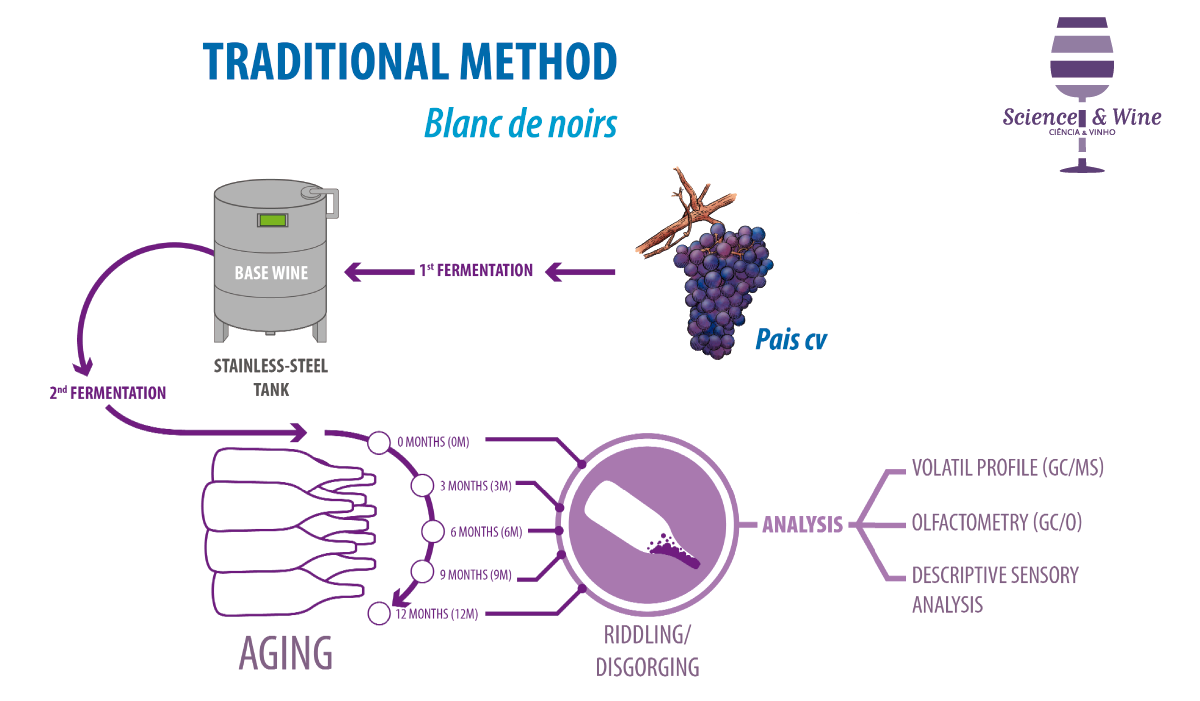By Cristina Úbeda and Mariona Gil i Cortiella
The production of sparkling wine following the traditional method (also named Champenoise) involves a winemaking of the grapes to obtain a base wine, and afterwards a second fermentation inside the bottle, followed by a period of contact on their lees during several months.
Thus, one of the main factors affecting the volatile composition of sparkling wines is the grape variety employed to elaborate the base wine. The most employed grape varieties to produce sparkling wine are white and have been well-studied (Ibern-Gómez et al., 2000; Francioli et al., 2003; Bosch-Fusté et al., 2007; Gallardo-Chacón et al., 2010; Ganss et al., 2011; Kemp et al., 2015), however, less is known about sparkling wine produced from red grape varieties. The grape variety used for this study corresponds to País cv. (Vitis vinifera), which is the most ancient vinifera grown in South America (since the mid-16th-century), originates from Tenerife, Spain (where is still cultivated and named Listán Negro). Despite that cultivation of this grape has been gradually decreasing since the 19th-century because of the introduction of French varieties (Lacoste et al. 2010), it is nowadays the second most grown red variety in Chile (12.520 ha), and currently it is used for sparkling wine production in Chile showing a great potential for the elaboration of this kind of wines.
Along the ageing period, a process of yeasts autolysis takes place, influencing the characteristics of the wine and its sensorial quality (Alexandre & Guilloux-Benatier, 2006; Martínez-Rodríguez et al., 2001), being the aroma one of the most affected features in this process. During autolysis, several volatile compounds are released to the wine, as well as some enzymes interact with aromatic precursors releasing their corresponding volatile molecules to the wine. Moreover, some of the volatile compounds might be adsorbed on lees, decreasing their concentration in the sparkling wines during aging (Comuzzo et al., 2006; Ganss et al., 2011). Therefore, the aging time determines the type and the quantity of volatile compounds present in sparkling wines (Riu-Aumatell et al., 2006).
In this context we planned to study the impact aroma compounds during the production of sparkling wine from grape juice (since base wine was made by white winemaking, obtaining a blanc de noirs wine), to obtain a base wine that undergoes a second fermentation into the bottle employing a Saccharomyces cerevisiae (ex r.f. bayanus) yeast for the second fermentation, obtaining a sparkling wine that going through aging on their lees. These results could be found in a recent published article (Ubeda et al., 2018).
Hence, the evolution of aromatic compounds from grape juice to sparkling wine with 12 months of ageing on their lees was monitored by gas chromatography coupled to mass spectrometry (GC/MS). Besides, the impact aroma compounds were evaluated during the second fermentation and ageing (it is from base wine to 12 months of ageing) by carrying out olfactometry techniques (GC/MS/O) and a sensory analysis with a trained panel. The combination of different analyses allowed having a fairly broad view of the changes that take place in the sparkling wine aromatic features during its production (Figure 1).
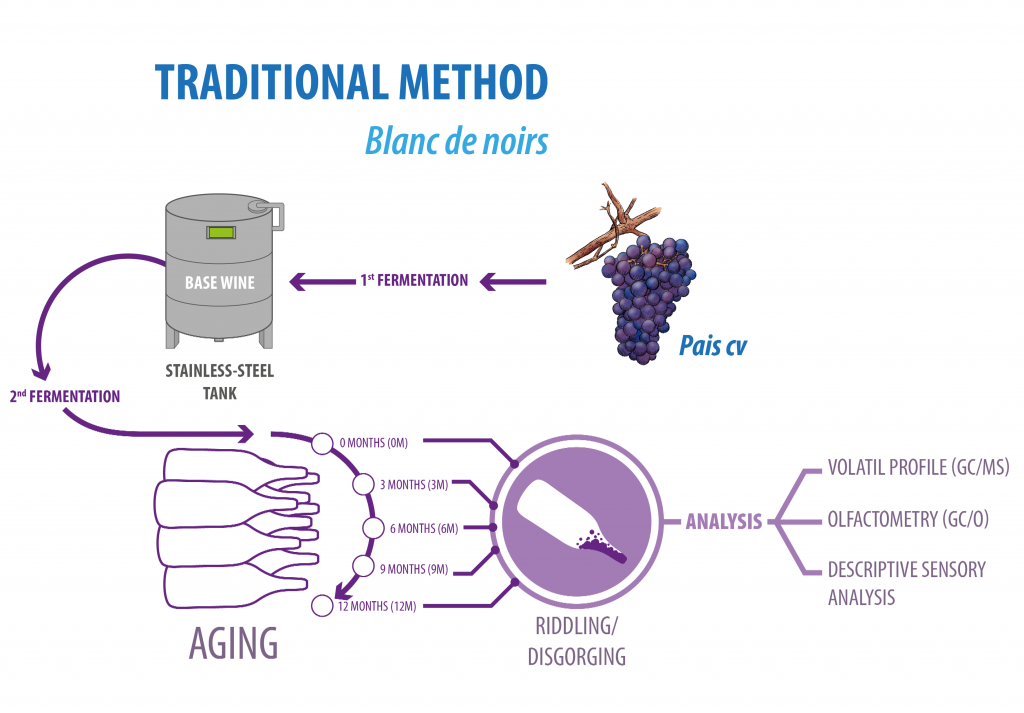
As can be observed in Figure 2, there was an important loss of esters during the second fermentation and throughout ageing, mainly due to the decrease of β-phenethyl acetate and isoamyl acetate. This loss might be due to adsorption onto lees, but also due to the chemical hydrolysis due to their thermodinamical unstability. Despite of this, it was observed that diethyl succinate, ethyl lactate, and methyl-2-oxo-nonanoate increased during aging and could be proper aging markers.
Several compounds increased their concentration during aging (e.g., norisoprenoids). These compounds appear glycosylated in the grape and are released by yeast enzymes during the fermentation or from these non-volatile precursors by hydrolysis under acidic conditions at wine pH (Williams et al., 1982; Riu-Aumatell et al., 2006). Based on our findings, we propose that, in the case of young sparkling wines (12 months in contact with lees), vitispiranes might be better aging markers than the typically used TDN. However, terpenes which also appear glycosidated in the grape, increase after alcoholic fermentation but decrease during aging on lees (Figure 2).
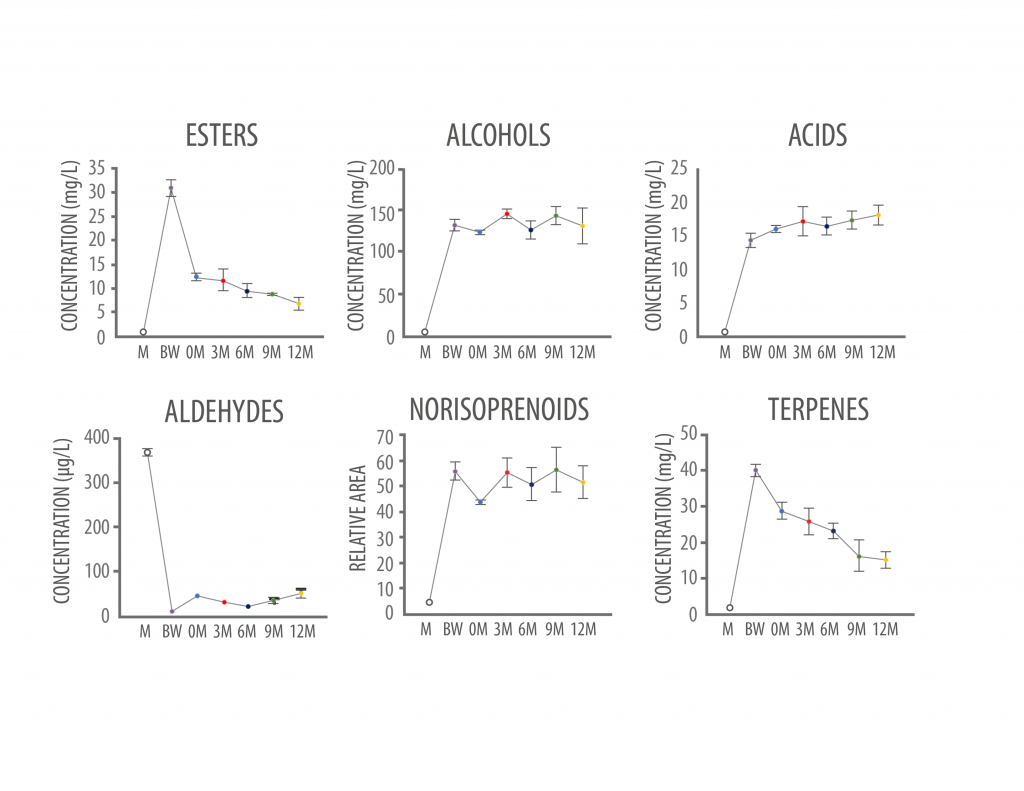
Olfactometry analyses exposed that 48, 47 and 38 odor-active zones were detected in the BW, 0M, 12M samples, respectively. Among these, 23 were perceived in all the stages of the production process. Figure 3 shows the contribution of each aroma category as a percentage of the total modified frequency (MF) of odor zones. In contrast to the GC-MS analysis results, the zones described as fruity aromas were similar when comparing the BW (39% of the total MF) and sparkling wine after the second fermentation (40%). However, a decrease of the total MF was observed after the 12 months of contact with lees (36%), supporting the loss of fruity nuances after aging, which is linked to the decrease of esters. Joint to the loss of fruity character, there was a decrease in the floral odor zones, however, these were not perceived in the sensorial trials (Figures 4). This suggests that the responsibility for fruity and floral nuances in sparkling wine resides in a few high-impact aromatic, such as ethyl isobutyrate, isoamyl acetate, ethyl hexanoate, and β-phenylethanol.
Finally, multivariate analysis performed with all the volatile compounds determined showing that Component 1 (PC1) seems to explain the variance among wines with different aging time. This pointed to diethyl succinate, ethyl lactate, and vitispirane as the best aging markers for this young sparkling wine since their loadings in PC1 were the greatest among all the volatile compounds, being in agreement with the results obtained by chemical analyses (Figure 5).
Those interested in a longer length report can download the working paper at:
https://www.sciencedirect.com/science/article/pii/S0963996918308184
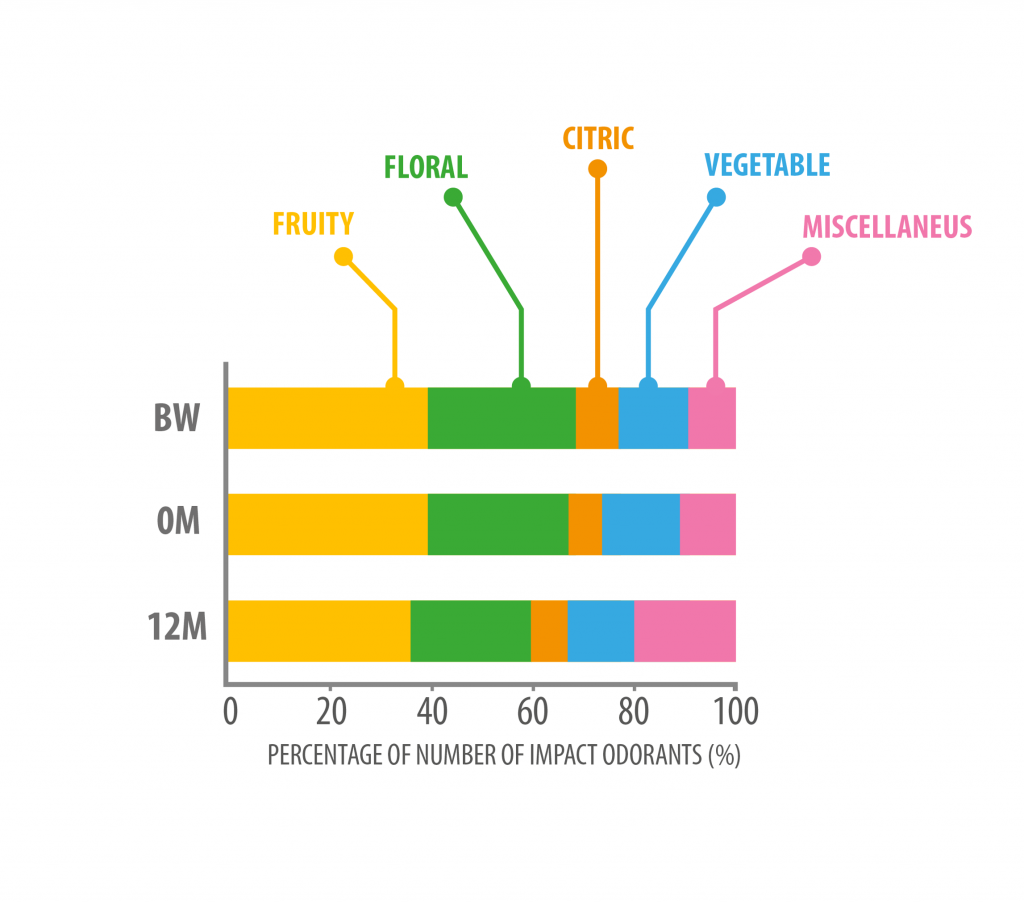
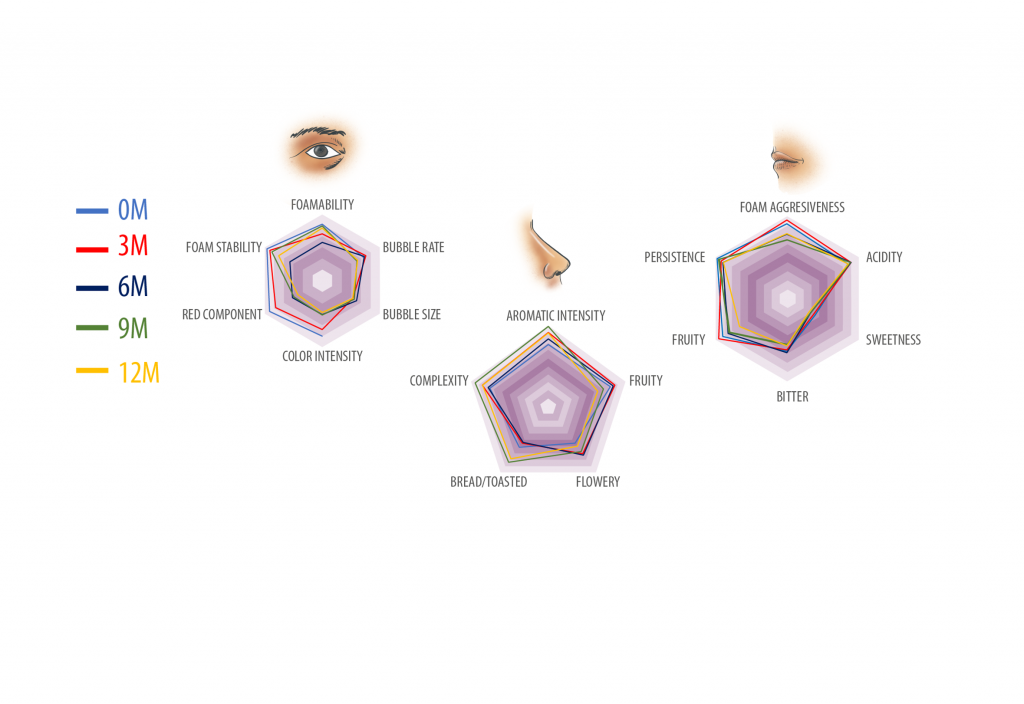
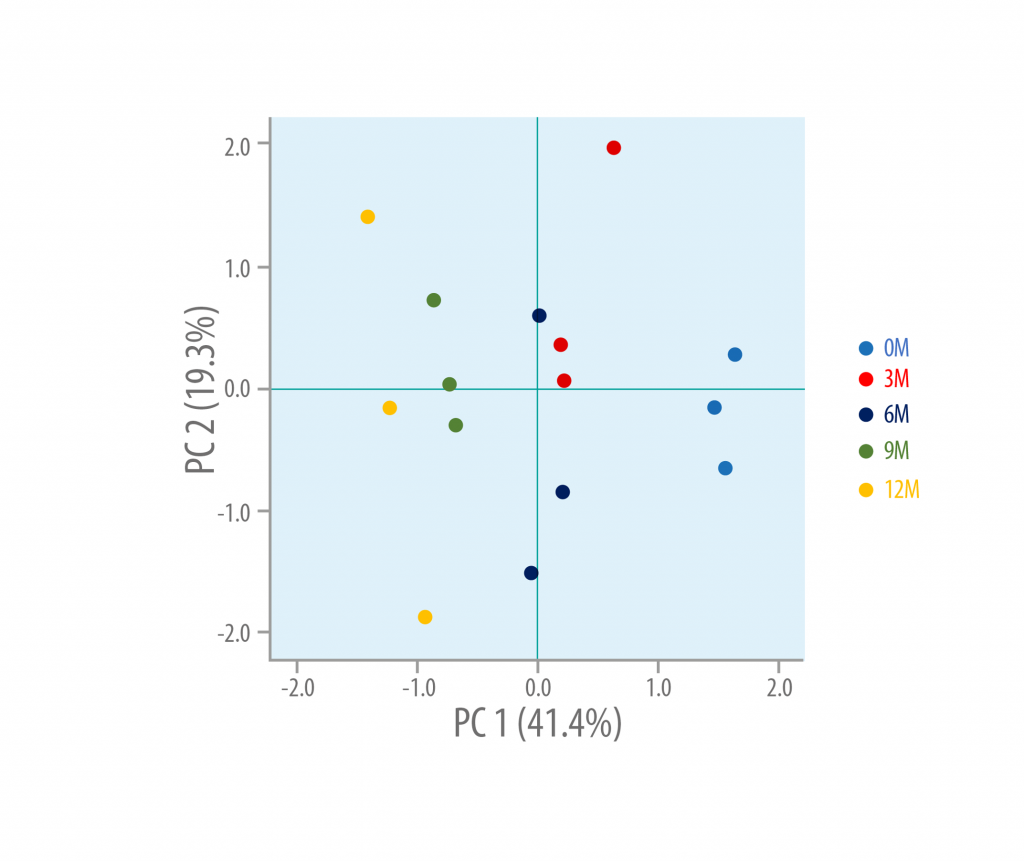
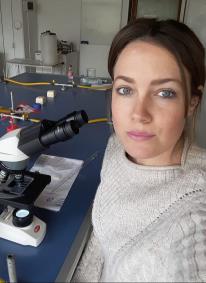
Dr. Cristina Úbeda Aguilera is an assistant professor at the Universidad Autónoma de Chile, located in Santiago. She has graduate degree in Pharmacy and master’s degrees in Microbiology applied to industrial biotechnology, Nutrition and Dietetics and Food Safety. During her PhD, carried out at the University of Seville (Spain) (2012), she acquired knowledge in techniques for extracting bioactive and volatile compounds and also, performing sensory analysis from different food matrices, mainly working with fermented beverages and seasonings. She has developed her research activity in University of Seville and Zaragoza (Spain), IFAPA Córdoba, CSIC (Spain), University of Lisbon (Portugal), University of Chile (Chile). Currently, her research is focused into two main lines: the study of certain technologies to improve Chilean sparkling wine quality and the search of new yeast strains of interest for the food industry.
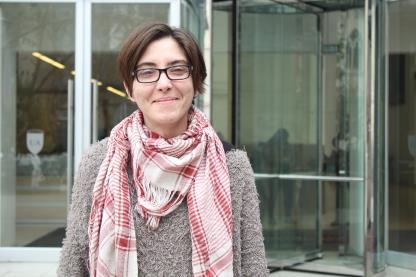
Dr. Mariona Gil i Cortiella is currently assistant professor in the Universidad Autónoma de Chile (Santiago de Chile, Chile), performing her research related with wine chemistry and wine technology in the Instituto de Ciencias Químicas Aplicadas, Inorganic Chemistry and Molecular Materials Center (ICQA), in collaboration with the Grupo de Investigación Enológica (GIE) of the Department of Enology and Agroindustry (University of Chile). She trained in the Universitat Rovira i Virgili (Tarragona, Spain), where she obtained a Bachelor of Science in Chemistry (2010), and a Bachelor of Science in Enology (2008), besides a Master of Science in Enology (2010), and a PhD in Enology and Biotechnology (2013). Her topics of research nowadays are related with the effect of the tanks used during winemaking on the chemical composition and sensory properties of Sauvignon blanc wines, and the characterization of cold and warm climate Syrah cv. wines from South America.
References
- Alexandre, H., & Guilloux-Benatier, M. (2006). Yeast autolysis in sparkling wine–a review. Australian Journal of Grape and Wine Research, 12, 119-127.
- Bosch-Fusté, J., Riu-Aumatell, M., Guadayol, J. M., Caixach, J., López-Tamames, E., & Buxaderas, S. (2007). Volatile profiles of sparkling wines obtained by three extraction methods and gas chromatography–mass spectrometry (GC–MS) analysis. Food Chemistry, 105, 428-435.
- Comuzzo, P., Tat, L., Tonizzo, A., & Battistutta, F. (2006). Yeast derivatives (extracts and autolysates) in winemaking: Release of volatile compounds and effects on wine aroma volatility. Food Chemistry, 99, 217-230.
- Francioli, S., Torrens, J., Riu-Aumatell, M., López-Tamames, E., & Buxaderas, S. (2003). Volatile compounds by SPME-GC as age markers of sparkling wines. American Journal of Enology and Viticulture, 54, 158-162
- Gallardo-Chacón, J., Vichi, S., López-Tamames, E., & Buxaderas, S. (2009). Analysis of sparkling wine lees surface volatiles by optimized headspace solid-phase microextraction. Journal of Agricultural and Food Chemistry, 57, 3279-3285.
- Ganss, S., Kirsch, F., Winterhalter, P., Fischer, U., & Schmarr, H. G. (2011). Aroma changes due to second fermentation and glycosylated precursors in Chardonnay and Riesling sparkling wines. Journal of Agricultural and Food Chemistry, 59, 2524-2533.
- Ibern-Gómez, M., Andrés-Lacueva, C., Lamuela-Raventós, R. M., Buxaderas, S., Singleton, V. L., & De La Torre-Boronat, M. C. (2000). Browning of cava (sparkling wine) during aging in contact with lees due to the phenolic composition. American Journal of Enology and Viticulture, 51, 29-36.
- Kemp, B., Alexandre, H., Robillard, B., & Marchal, R. (2015). Effect of production phase on bottle-fermented sparkling wine quality. Journal of Agricultural and Food Chemistry, 63, 19-38.
- Lacoste, P., Yuri, J. A., Aranda, M., Castro, A., Quinteros, K., Solar, M. et al. (2010). Variedades de uva en Chile y Argentina (1550-1850): genealogía del torrontés. Mundo Agrario, 10, 7-8.
- Martínez-Rodríguez, A. J., Polo, M. C., & Carrascosa, A. V. (2001). Structural and ultrastructural changes in yeast cells during autolysis in a model wine system and in sparkling wines. International Journal of Food Microbiology, 71, 45-51
- OIV. The International Organisation of Vine and Wine. (2017). 2017 World Vitiviniculture Situation OIV Statistical Report on World Vitiviniculture. http://www.oiv.int/public/medias/5479/oiv-en-bilan-2017.pdf
- Ubeda, C., Kania, I., Del Barrio-Galán, R., Medel, M., Gil, M., Peña-Neira, A. (2019). Study of the changes in volatile compounds, aroma and sensory attributes during the production process of sparkling wine by traditional method. Food Research International. doi:10.1016/j.foodres.2018.10.032
- Williams, P. J., Strauss, C. R., Wilson, B., & Massy-Westropp, R. A. (1982). Studies on the hydrolysis of Vitis vinifera monoterpene precursor compounds and model monoterpene. beta.-D glucosides rationalizing the monoterpene composition of grapes. Journal of Agricultural and Food Chemistry, 30, 1219-1223.

